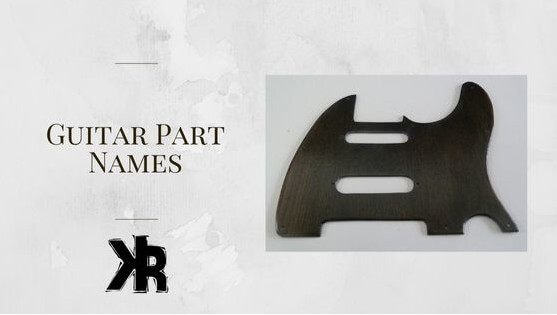Table of Contents
If you are just learning how to play, it’s very helpful to know the guitar part names and what they do. This can change how you play and handle the instrument. Each part is referenced in the learning process. Knowing their names and functions can be helpful.
Not only will it help to communicate with others, but it may assist you in further development in becoming a good guitar player. It will also be helpful when it comes to purchasing new guitars, or upgrading parts on the ones you already own!
There are some differences between acoustic and electric guitar anatomy. They are very important to know. This can potentially make part shopping a better experience.
How Many Parts Does A Guitar Have?
The answer to this question is different between the many guitar designs. Acoustic and electric guitars have many similarities. But they do differ, as they are meant for different styles.
Acoustic Parts
The acoustic guitar in most cases has 15 main parts. Some are exclusive to this design and help it to perform as intended. Both in sound and playability. Here are some of the parts you will find on an acoustic guitar:
- Body.
- Neck.
- Head stock.
- Tuners.
- Nut.
- Frets.
- Markers.
- Sound Hole.
- Pick Guard.
- String Pins.
- Strings.
- Saddle.
- Fret Board.
- Bridge.
- Truss Rod.
Electric Parts
The electric guitar is similar except for a few more main parts. If we had to narrow it down, we could say the electric guitar has 20 main parts. The 5 extra parts are:
- Pick-ups.
- Pick-up Selector Switch.
- Volume and tone controls.
- Input Jack.
- Tremolo Arm.
Acoustic Guitar Parts Diagram
In the below diagram, you will see the main acoustic guitar parts and their names. While there are different kinds of acoustic guitars like steel-string and nylon, the parts are the same. Yet, there are certain differences like cutaways and pickguards.
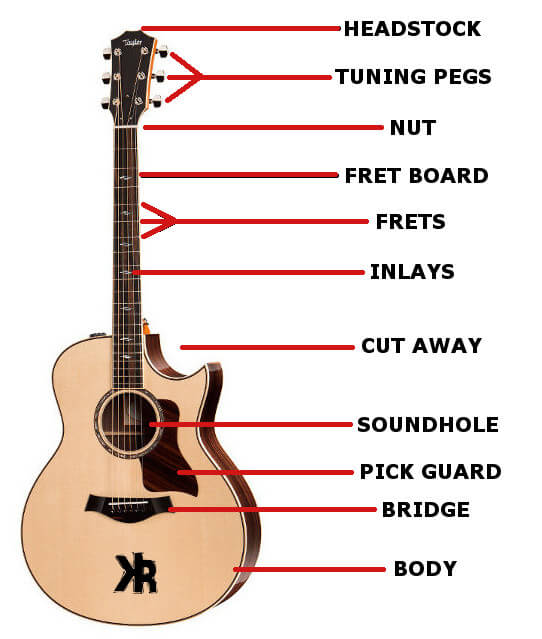
Electric Guitar Parts Diagram
The electric guitar has many more parts than an acoustic. With the addition of pickups and the electronics that go along with them, the part count is increased!
This means that there is more to remember and learn how to use. But don’t look at this as a negative, because each new part adds more enjoyment and possibilities to the guitar! Below is a diagram of the Fender Stratocaster and the most common parts of the electric guitar.
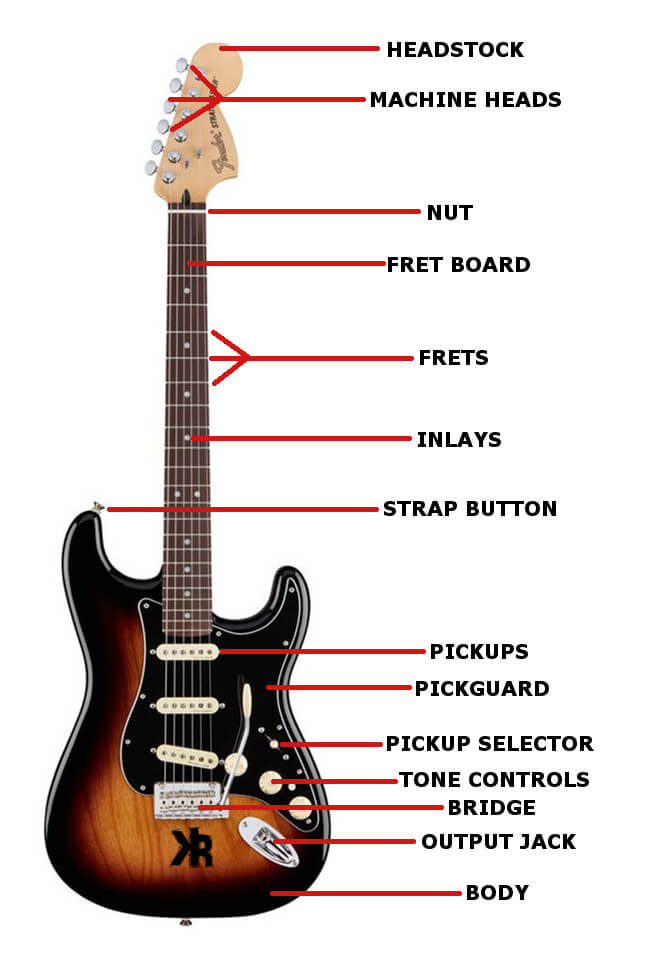
In addition to this, there are many electric guitar parts that you can choose from. For example, in the diagram, the pickups are called single coils. This is one kind of pickup that you can select from.
Another is called a humbucker which is a bit larger and offers a different tone and performance. The guitar bridge is similar, as there are many designs. Anything from a fixed style to some that offer tremolo options and whammy bars. They allow you to bend your strings for great sounds.
3 Main Guitar Parts
There are many guitars on the market today that have different shapes and sizes. But even though there are so many shapes, they all share some of the same parts.
There are three main parts of the guitar that are fundamental. Every player should know these names.
- The guitar head, also known as the head stock.
- The neck.
- The body.
These are the parts that create the look, the integrity, the sound and so much more. Every other part of the guitar will exist in one of these main sections. This makes them very important to know as a player.
We will look into these parts in more detail in this article, but take some time to get to know and recognize them. Especially if they are not familiar to you at this point.
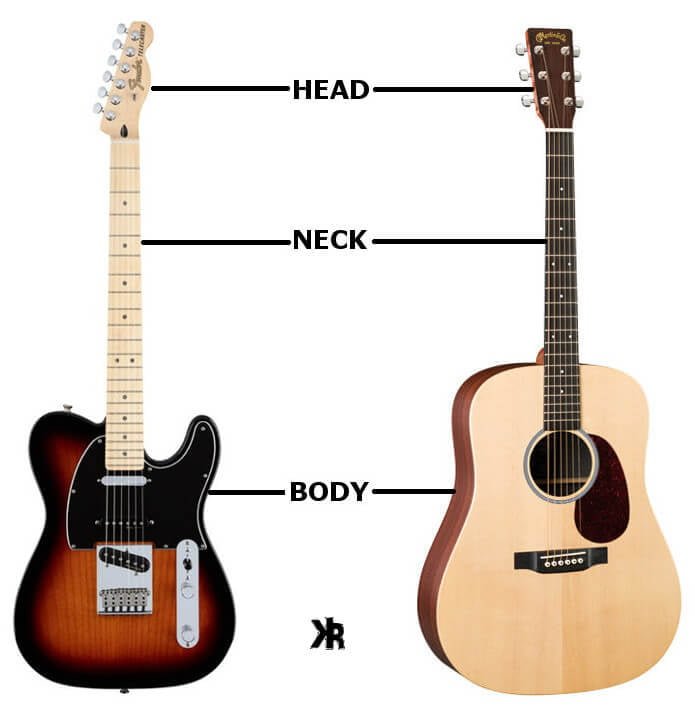
Guitar Body
The guitar consists of many important parts, but when it comes to the body, this is where they all come together. The body is normally made from wood, but you might find fiberglass and other materials.
An acoustic and solid-body electric guitar differ a considerable amount. This makes it worth looking into in order to know the proper terms.
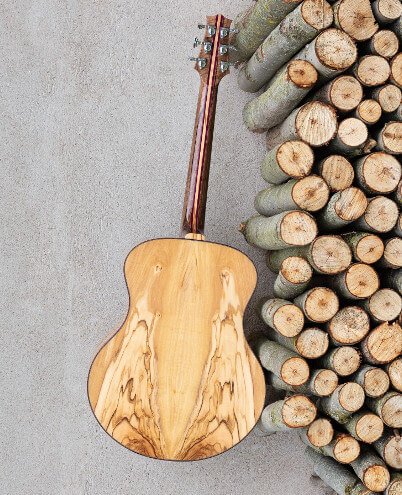
Acoustic
The acoustic body is where many things happen. First, it isn’t a solid piece of wood. The acoustic body is assembled with different pieces to form it. The top, sides, and back are assembled together with glue in special jigs.
The acoustic guitar body is made with bracing. This helps to strengthen it under the stress of the string tension. The bracing has to be installed to allow the body to resonate correctly to produce good bass and volume.
So a manufacturer has to be strategic about how they brace the acoustic guitar body. Yamaha has created a page on their website going into detail on how they assemble their acoustic bodies here.
A great example of this body style is the dreadnought. It’s one of the most popular acoustic guitar shapes today.
Sound Hole
The acoustic guitar body is where the volume is produced and is a resonant chamber. In the middle is a hole that projects the sound when the strings are strummed. This is called the sound hole.
The sound hole can be many shapes, even though the more common is round. You can also find oval holes or even multiple located on different parts of the body. This all depends on the look of the guitar and the method of sound delivery the designed was after.
Electric
The electric guitar body is quite a bit different. The body is normally a solid piece of wood that is milled to hold your pick-ups and other parts.
However, on an electric, the body doesn’t project sound like an acoustic. Or even a hollow body guitar. Some people believe that the electric guitar body has no effect on tone. But that simply isn’t true!
The tone wood used to create an electric guitar body vibrates with the strings. Each kind will vibrate differently from the others. The solid body also helps to mitigate feedback that is problematic with hollow designs.
This does have an effect on the sound. Even though the pick-ups do most of the heavy lifting when it comes to the sound produced by an electric.
Guitars like the Stratocaster, Telecaster and Les Paul are solid body.
Guitar Body Differences
There are many acoustic guitar body shapes and sizes, from hollow to solid. There are also many kinds of woods that affect the sound and feel of a guitar. Whether it’s acoustic or electric, the material used will impact how it sounds.
The body is a very important part of any guitar and is one of the names you should know. Especially when it comes to buying the guitar that will best fit you as a player.
For example, an acoustic guitar with steel strings can be purchased with or without a cutaway. This cutaway in the body is desired by some players and not so much by others.
It would be a shame to buy an expensive acoustic without a cutaway only to realize you are a player who would want it! And so understanding some of these small details is very important.
And to be honest, most players do not know what a body cutaway really is and its benefit of accessing the upper frets. It may not be a part, but it’s an important name and feature!
As you can see in the diagram below, the cutaway is a rather big deal and a name that should be remembered. One day, when you are buying a guitar, the guy in the music store may ask if you prefer a cutaway or not.
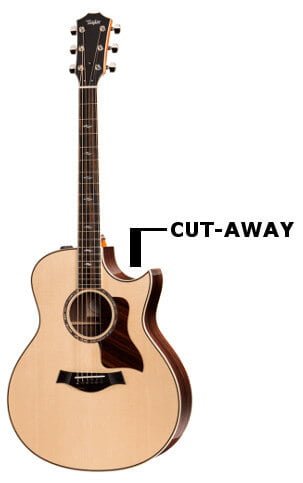
Parts on a Guitar Body
We have looked at how important the guitar body is to the playability of the instrument. There are a few other parts that are equally important. These parts are found on the body and contribute to the instrument in ways only they can.
Guitar Bridge
The bridge on an acoustic is very different from that of a solid body electric. It plays a big role in not only anchoring the strings, but also transferring their energy into the body.
This helps amplify the vibrations, which produces its volume and sound. The strings are usually anchored with pins that press into the bridge and keep them tight and secure. These are called bridge pins
On an electric guitar, the role is similar. The bridge supports the strings on the body side of the guitar and transfers vibration. While this vibration contributes to the sound of the solid body, it doesn’t play as large a role as on an acoustic.
Some electric guitar bridge designs include a cover that can go over the top. The Telecaster bridge cover is one that also affects the sound slightly.
The materials for the bridge on an acoustic are normally made out of wood. While on the electric guitar it’s going to be metal as seen in the diagram below.
This also opens up another part name category called the whammy bar. This one many people have heard of, but most don’t understand how they work.
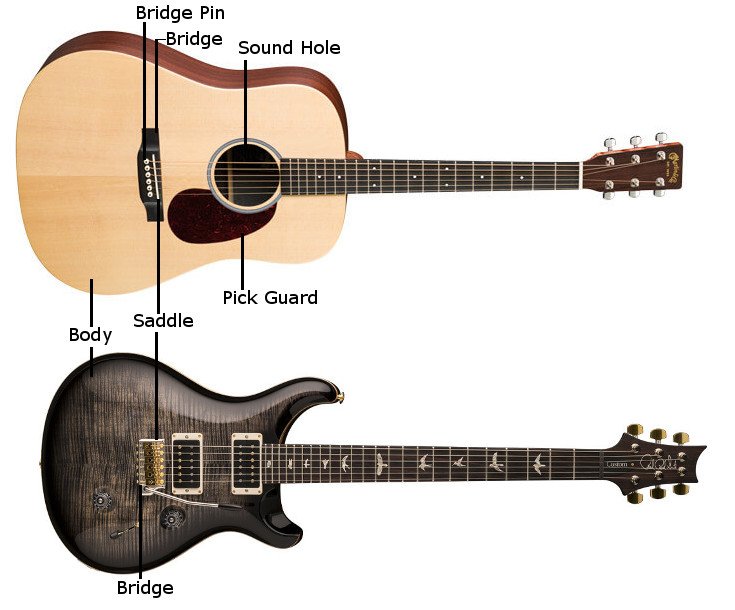
Saddle
The saddle on any guitar determines where the portion of the playable string begins and ends. It also sets intonation and length. On an acoustic guitar, the saddle is normally a thin piece of bone, plastic, or Tusq. In some cases, the saddle on an acoustic is also compensated for intonation purposes.
On an electric guitar, the saddle is quite a bit different. The saddle will in most cases be individual to each string. This allows the intonation to be set according to the requirement of each string.
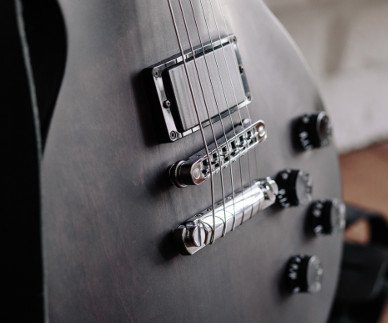
Whammy Bar Or Tremolo Arm
There are many bridge designs available for the electric guitar. This is absolutely one of the guitar part names you should know and understand. The more common design is a fixed bridge, which doesn’t allow for a whammy or tremolo bar.
A bridge that allows for a whammy bar or tremolo arm will change the pitch of the strings by simply using the lever. The arm on the bridge will allow you to lessen tension on the strings when pushed forward.
This is a tremolo arm and will only allow you to lower the pitch of the strings. A Floyd Rose bridge on the other hand is floating. This allows you to lessen or tighten the tension. This can change the pitch of your strings in some incredible ways very quickly.
Pick Guard
The pickguard is located under the sound hole on an acoustic. And around the pick-ups on an electric guitar. This part is normally made of plastic and is added to the guitar to prevent scratches on the finish from picks. Sometimes you will find it being referred to as a scratch plate.
Not all guitars have pick guards, but it’s more common to see them equipped. This is because it’s very common to see a guitar finish dulled due to pick hits. They also look quite nice on some guitars and so add to the overall aesthetic pleasure.
Electronic Parts
Guitar Pickups
There are many guitar pickups available today. From single coil pick-ups to humbuckers, they are a huge contributor to your tone!
There are many companies that are producing state-of-the-art technology in pick-ups. But today we are going to look at a few of the more common ones that are known throughout history. So what is a pick-up, and how does it work?
A pick-up is a transducer that uses induction. This is a device that converts one type of energy into another. In the case of a guitar pickup, we are translating the string vibration into an electrical signal. You can then send it to an amplifier.
There are magnets that create a field around the pickups. When you strike a string, the magnetic field responds to the vibration. Next, you have wire wrapped around the magnets.
When the magnetic field reacts to the vibrating string, a signal is produced. This happens in the wire and is sent out to an amplifier from the output jack. This is how we can amplify the signal created by the pick-up.
There are many pick-ups, as I mentioned earlier, both for acoustic and solid body electric. So, selecting the right pickup will provide you with the sound you are looking for. Whether it’s a country-style sound or a metal tone, your pickups will get you there!
Pickup Selector Switch
If you have more than one pick-up on your guitar, then normally there should be a selector switch. This switch is used to either combine the pick-up sounds altogether, or select only one.
The strings produce different sounds all along their length. The pick-ups placed at different points capture these sounds.
The selector switch gives you different sound options on the fly! Because players love options as much as we do, this switch is a wonderful addition to any guitar! Some selector switches have 5 different positions! That’s right, you heard me correctly, 5 positions!
And every single position is a wonderful useable tone! If you have ever played a Stratocaster, you know what I mean. But your options will consist of a bridge and a neck position pick-up. These will cover most bases for the sound you might be going for.
Tone and Volume Controls
Next in line are your tone and volume control knobs. The volume control simply adjusts the amount of signal that is sent from the output jack.
Some guitars have a volume control for each pick-up. Others are global and control the entire guitar’s output. The tone control is what’s called a low-pass filter. It’s a potentiometer and capacitor circuit that will alter the brightness.
This can be handy when looking for darker sounds and normally has a large impact on your tone. Most guitars will include a tone control for each pick-up to get many sounds.
The circuit can also be modified with certain values of capacitors to get a different tone. If you know a bit about electronics, this is another way of finding more tone variation.
Output Jack
The output jack allows you to send your guitar signal from the pick-ups to the amplifier. The signal from the output jack is instrument level. It’s sent through a mono instrument cable when connected.
Both acoustic and electric guitars can use an output jack. They are a universal connection point. You will see an output jack on all electric guitars. Whereas an acoustic must have a pickup system installed.
Guitar Neck
The guitar neck is another part that does some heavy lifting. This is where you will find that there are many sizes of necks and profiles! Finding the right one for you will change your experience with the guitar. Knowing these guitar part names will be a long term benefit!
The neck is normally made of wood and connects to the body of the guitar with either bolts (bolt-on) or glue and joints (set). There are a few different joint styles that are used, but the dovetail is the most common.
Otherwise, if it’s bolted with screws, a metal plate is visible at the heel. Some manufacturers also use this plate for serial numbers or brand logo.
The tone wood and grain direction that the neck is made from can have an effect on your guitar sound.
Related: What is a guitar heel?
Neck Profiles
You will find that there are a number of guitar neck profiles available. Each neck shape has its benefit, and some guitarists gravitate to a particular radius. Whether it’s for speed or comfort, you will know when you find your favorite neck profile. Here are some common shapes:
C Shaped Neck
The C shaped guitar neck is the most common profile out there. Fender guitars are known to use them on most of their models as it offers comfort and great play ability. Most players prefer the C shaped neck, which can be found in slim versions as well as thick!
The C shape neck also has a smooth curve to it that professional players really like. The way the neck resonates is enjoyable and very musical.
U Shaped Neck
The U profile neck is thicker with a more pronounced radius. This neck is rounder and preferred by players with bigger hands. This particular neck was largely found on older Fender guitars. It’s known as the baseball bat of guitar necks and is not for everyone.
This neck shape is common on Telecaster guitars, especially older models. They are prefect for rhythm players as they are easy to hold and feel thick.
D Shaped Neck
The D profile guitar neck is very popular for players who seek speed. It’s known as a modern flat oval and is one of the newer shapes. This neck radius can be found on a lot of rock and metal guitars because of the comfort and slim profile.
They are a versatile neck shape and work great for soloing and lead lines, but can do rhythm just the same.
Parts Of A Guitar Neck
There are a few different parts of the neck that are important to know. And as you will see, this makes them essential names to have memorized!
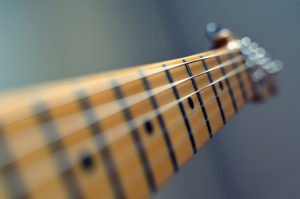
Fingerboard
The fingerboard is also known as the fretboard. This is a very important part of any stringed instrument and is one that you should know on the guitar.
It’s a thin long strip of material, often wood, that is laminated to the front of the neck. The strings then run along the fingerboard. Depending on where you press down on the string, this will change their sound.
The Fingerboard, when made from wood, is normally maple or rosewood. But some companies have been using different materials. Richlite is one, which is very durable and is easier on the environment!
The fingerboard also contributes to your sound and has a specific radius. And so the material used will also play a role to some degree. As we have seen above, the neck has many shapes. The fretboard also has a couple of different designs.
Flat Fretboard
This is the most common style of fretboard on guitars. The flat fretboard is simple. The strings run across the fretboard from nut to bridge. When you press down on the string, a sound is produced. If you have played the guitar, it was more than likely a flat board.
Scalloped Fretboard
The scalloped fretboard is quite different and is only for a select few players. This design has material missing in the neck between the frets to produce small cutaways. This makes the frets much higher, so it’s harder to press the strings down on the fretboard.
Players who desire this fretboard are normally shredders. The scalloped design enhances the articulation of the notes. This is very desirable for a person who plays fast! But it does take some getting used to.
Guitar Frets
Frets are strips of metal wire that span the fingerboard from one end to the other. They are usually made from nickel or brass. The fret’s role is to divide the neck into different intervals. And each fret is a semitone created by pressing down on the string.
You are essentially raising the pitch of the resulting note by a half-step or semitone. The frets are placed on the neck strategically to get the exact note that you want to play.
If a fret is put onto the neck incorrectly, the intonation would be out of adjustment. The notes would then not be accurate. See the diagram below for reference.
On a guitar with no frets, you have to learn exactly where to press on the fingerboard to get the note to sound right. On a guitar with frets, you don’t need to find the exact spot of a note. The fret takes care of it for you.
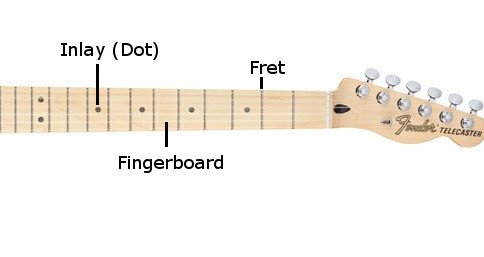
Inlays Or Fret Markers
Inlays are decorative elements on a guitar that are set into the wood. Inlays are used to mark fret positions on a fingerboard and also for decoration. The design of the inlays varies from each manufacturer and can be many things.
Dots are most common, but some manufacturers get really creative. An Epiphone Les Paul Standard, for example. You will also find inlays around the sound hole on an acoustic guitar, as well. The headstock of most guitars may have inlays around the manufacturer’s logo.
But it’s also common to find inlays on the back of the neck, which is called a stringer. A stringer serves to fill in the gap where the truss rod is installed in the neck.
Inlays are made of different materials from plastic, pearl, ivory, and exotic woods. Sometimes you will find paint. Depending on the cost of the guitar, the inlays will be a nicer material.
Guitar HeadStock
At the very end of your neck, you will find what is called the headstock. The headstock is another important part of the guitar.
Some guitars might have a different kind of wood than the neck. This is done with special wood joints depending on the value of the guitar.
Because the strings are directly connected to the headstock, care is taken to ensure it’s strong. The last thing you want is the headstock to break off due to the string tension! There are a few different shapes of headstocks. Each style claims to offer different strengths and benefits.
Straight Headstock
The straight headstock runs inline with the neck and does not offer any tilts or bends. This head shape is commonly found on Fender Stratocaster guitars. It’s sometimes referred to as a flat head. It’s a very simple headstock design, but is rigid and sturdy.
Angled Headstock
The angled headstock is pretty common on most guitars and forms an acute angle with the neck. It’s designed to help draw the strings over the nut without having to add any aligning clips.
The last thing you want is your strings to come out of the nut when playing aggressively. The angled head design helps keep good string tension on the nut to prevent this. This design is quite common on Gibson guitars, like the Les Paul.
Headless
Some guitars are designed without a headstock at the end of their necks! These instruments normally have their tuners at the bridge of the guitar and clamp the string at the end of the neck. Headless guitars are said to have a number of benefits like:
- Shorter.
- Lighter.
- Balanced.
- Easier string changes.
The look of the headless guitar is not for everyone, but they do have their place in many metal genres. Brands like Strandberg and Kiesel use this design on their guitars.

Truss Rod
As mentioned above, the truss rod plays a rather large role in the curve of your neck. This rod runs through the neck from one end to the other and helps to deal with the tension of the strings.
Without this rod, the neck would bow so badly that the strings would not be playable. And eventually, the neck would warp or break.
When the rod is adjusted correctly, the neck will have a bow to it that keeps the strings comfortable to play. This is called the string action. If you have to press down hard on the strings to play them, this would mean the truss rod needs an adjustment.
The truss rod also prevents the strings from vibrating against the frets. It also plays a role in the guitar’s intonation. Adjustment of the truss rod is a delicate process. It should only be done once you understand the procedure. But in most cases, it’s always best to take it to a professional.
If done incorrectly, you could damage your guitar beyond repair. Remember this guitar part, but be careful how quickly you dive in and adjust it!
Parts Found On The Guitar HeadStock
Let’s look at some parts you will find on the head stock. These are some guitar part names you need to know.
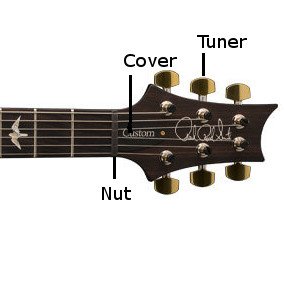
Guitar Tuners
The tuners, or machine heads, are used to tune the strings on the guitar. They are mechanical assemblies with a pinion and worm screw that allow you to turn a shaft to tighten or loosen the strings. There are different tuners, each kind used depends on the guitar.
Some are made from die-cast metal, and others of brass. You might also find that some have different configurations. The type of tuning pegs you find on a steel string guitar is very different from what is on a model made for nylon.
Your tuners are very important parts of your guitar. Learning to use them is critical to playing and staying inspired. Even just learning how to properly change the strings is important. It’s possible to wind too much string around a machine head and have problems arise.
Some guitars come with a bridge that allows the player to bend the stings. As a result, some instruments are provided with what’s called locking tuners.
These prevent the string from going out of tune when you bend them. Tuners are very dynamic, and you will need to know how to use them. Don’t be afraid to use your tuners!
Let’s take a look at this video to get an idea of how to use the tuners on your guitar. This is very important to know if you are a beginner!
Guitar Nut
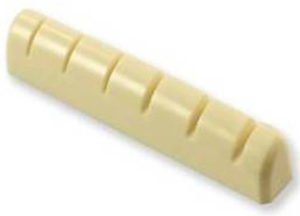
The nut on your guitar is the thin piece of material that your strings run through at the end of the neck. You will find it right before the headstock.
This nut is a very important part of the guitar and can make a poor playing experience if not done right. The nut controls the spacing of the strings. The distance from the edge of the fingerboard to the first fret and the height above it.
Nuts are made from a variety of different materials. Some of the materials include plastic, bone, ivory, graphite, and ebony.
Some materials are better than others, but all work well as selected by the builder. Nuts are selected based on the value of the guitar in some cases, so a cheaper material might be used.
The nut has an effect on your sound as it connects to the wooden neck of the guitar and resonates through it. A worn-out nut can usually create fret buzz issues as well as tuning problems. Sometimes even strings slip out!
With older guitars, it’s always recommended that the nut be replaced if worn out. A guitar part this simple can have a large effect on whether you get a good experience or a bad one!
Locking Nut
There is one guitar nut that deserves a mention, and that is the locking design! This nut is designed to clamp the strings between 2 pieces of metal. It prevents them from moving when tension is increased significantly.
This is usually the case with Floyd Rose, or vibrato system set-ups, where you can alter the string tension. It prevents the guitar from going out of tune when the system is used. The locking nut is a crucial part of the Floyd rose setup.
Truss Rod Cover
If you have ever wondered what that little plastic cover does on your head stock, wonder no more. Underneath that cover is your truss rod adjustment point. Your truss rod helps assist your neck with the stress of the string tension it’s always under.
The neck has a certain curve to it that we want to maintain for great action and play ability. Your truss rod maintains this curve so that you can have a better playing experience. But just be warned, if you do not know how to adjust this truss rod, it’s best to leave it to the pros!
String Trees
String trees, also known as string retainers or string guides, are small hardware components commonly found on electric guitars, particularly those with flat headstocks.
Their primary function is to maintain proper string tension and angle over the nut, which is essential for consistent tuning stability and optimal string vibration.
By guiding the strings at a particular angle, string trees help prevent tuning issues and reduce the likelihood of string slippage from the nut slots.
These components are usually made of metal and are secured to the headstock with screws. While they are most commonly associated with electric guitars, some specialized acoustic and classical guitars may also feature string trees for similar tension and angle adjustments.
Guitar Strings
Guitar strings are a critical component that significantly influences the sound and playability of the instrument. These strings can be made from a variety of materials, each contributing to different tonal qualities.
For example, electric guitars often use nickel or steel strings, which are known for their bright and clear sound. Acoustic guitars frequently employ phosphor bronze or 80/20 bronze strings, which offer a warm, resonant tone.
Classical guitars, on the other hand, typically use nylon strings. These strings produce a softer, more subdued tone, making them ideal for classical music styles. The choice of string material is thus closely related to the genre of music one intends to play.
The gauge, or thickness, of the strings also plays a significant role. Thicker strings produce a fuller, richer sound but require more finger strength to play. Thinner strings are easier to manipulate, but may lack the desired depth in tone.
The gauge of string used on the guitar also plays a role on how much tension is applied to the neck. The thicker they are, the more force that is applied.
String action, defined as the distance between the strings and the fretboard, is another important consideration. A high action makes the strings harder to press down, while a low action may result in unwanted buzzing sounds.
Conclusion
It’s very important to know what the different parts of the guitar are called and what they do. If you are just getting started, it will give you a bit of confidence as you begin.
Normally, new players are intimidated by the parts, not knowing what they do. This can make it hard to get comfortable with the instrument and be able to focus on learning. Experienced players can benefit from knowing their guitar parts as well.
This will help when communicating with other players or even upgrading parts. Aftermarket parts are a wonderful way to upgrade a guitar and give it your sound.
But if you don’t know much about the parts or even their names, it can be difficult to get what you are looking for. My advice would be to really consider learning about the parts and their functions.
You will see that when you know them well, it will provide a better overall experience.

